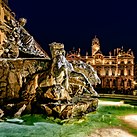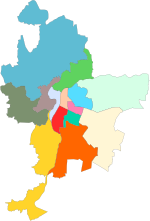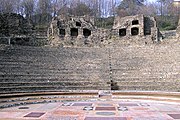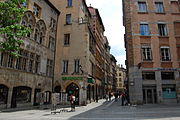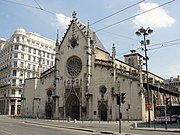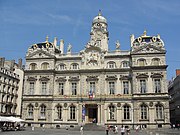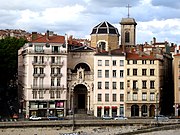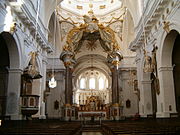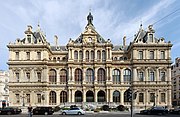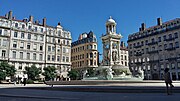A | B | C | D | E | F | G | H | CH | I | J | K | L | M | N | O | P | Q | R | S | T | U | V | W | X | Y | Z | 0 | 1 | 2 | 3 | 4 | 5 | 6 | 7 | 8 | 9
Lyon
Liyon (Arpitan) | |
|---|---|
Prefecture and commune | |
Top: Basilica of Notre-Dame de Fourvière, Place des Terreaux with the Fontaine Bartholdi and Lyon City Hall at night. Centre: Parc de la Tête d'or, Confluence district and Vieux Lyon. Bottom: Pont Lafayette, La Part-Dieu Central Business District with Place Bellecour in foreground during the Festival of Lights. | |
| Motto(s): Avant, avant, Lion le melhor (Old Franco-Provençal for "Forward, forward, Lyon the best")[a] Virtute duce, comite fortuna ("With virtue as guide and fortune as companion")[b] | |
| Coordinates: 45°46′N 4°50′E / 45.76°N 4.84°ECoordinates: 45°46′N 4°50′E / 45.76°N 4.84°E | |
| Country | France |
| Region | Auvergne-Rhône-Alpes |
| Metropolis | Lyon Metropolis |
| Arrondissement | Lyon |
| Subdivisions | 9 arrondissements |
| Government | |
| • Mayor (2020–2026) | Grégory Doucet (EELV) |
| Area 1 | 47.87 km2 (18.48 sq mi) |
| • Urban (2020[2]) | 1,141.4 km2 (440.7 sq mi) |
| • Metro (2020[3]) | 4,605.8 km2 (1,778.3 sq mi) |
| Population (Jan. 2019)[4] | 522,969 |
| • Rank | 3rd in France |
| • Density | 11,000/km2 (28,000/sq mi) |
| • Urban (Jan. 2019[5]) | 1,685,494 |
| • Urban density | 1,500/km2 (3,800/sq mi) |
| • Metro (Jan. 2019[6]) | 2,280,845 |
| • Metro density | 500/km2 (1,300/sq mi) |
| Time zone | UTC+01:00 (CET) |
| • Summer (DST) | UTC+02:00 (CEST) |
| INSEE/Postal code | 69123 /69001-69009 |
| Elevation | 162–349 m (531–1,145 ft) |
| Website | www |
| 1 French Land Register data, which excludes lakes, ponds, glaciers > 1 km2 (0.386 sq mi or 247 acres) and river estuaries. | |
Lyon (French: (![]() listen); UK: /ˈliːɒ̃/,[7][8] US: /liˈoʊn/,[9][10][c]; Arpitan: Liyon, pronounced ; Occitan: Lion, hist. Lionés[12]), also spelled in English as Lyons, is the third-largest city and second-largest metropolitan area of France. It is located at the confluence of the rivers Rhône and Saône, 391 km (243 mi) southeast of Paris, 278 km (173 mi) north of Marseille, 113 km (70 mi) southwest of Geneva, and 50 km (31 mi) northeast of Saint-Étienne.
listen); UK: /ˈliːɒ̃/,[7][8] US: /liˈoʊn/,[9][10][c]; Arpitan: Liyon, pronounced ; Occitan: Lion, hist. Lionés[12]), also spelled in English as Lyons, is the third-largest city and second-largest metropolitan area of France. It is located at the confluence of the rivers Rhône and Saône, 391 km (243 mi) southeast of Paris, 278 km (173 mi) north of Marseille, 113 km (70 mi) southwest of Geneva, and 50 km (31 mi) northeast of Saint-Étienne.
The city of Lyon proper had a population of 522,969 in 2019 within its small municipal territory of 48 km2 (19 sq mi),[13] but together with its suburbs and exurbs the Lyon metropolitan area had a population of 2,280,845 that same year,[6] the second most populated in France. Lyon and 58 suburban municipalities have formed since 2015 the Metropolis of Lyon, a directly elected metropolitan authority now in charge of most urban issues, with a population of 1,411,571 in 2019.[14] Lyon is the prefecture of the Auvergne-Rhône-Alpes region and seat of the Departmental Council of Rhône (whose jurisdiction, however, no longer extends over the Metropolis of Lyon since 2015).
The capital of the Gauls during the Roman Empire, Lyon is the seat of an archbishopric whose holder bears the title of Primate of the Gauls. Lyon became a major economic hub during the Renaissance. The city is recognised for its cuisine and gastronomy, as well as historical and architectural landmarks; as such, the districts of Old Lyon, the Fourvière hill, the Presqu'île and the slopes of the Croix-Rousse are inscribed on the UNESCO World Heritage List. Lyon was historically an important area for the production and weaving of silk. Lyon played a significant role in the history of cinema since Auguste and Louis Lumière invented the cinematograph there. The city is also known for its light festival, the Fête des Lumières, which begins every 8 December and lasts for four days, earning Lyon the title of "Capital of Lights".
Economically, Lyon is a major centre for banking, chemical, pharmaceutical and biotech industries. The city contains a significant software industry with a particular focus on video games; in recent years it has fostered a growing local start-up sector.[15] The home of renowned universities and higher education schools, Lyon is the second-largest student city in France, with a university population of nearly 200,000 students within the Metropolis of Lyon.[16] Lyon hosts the international headquarters of Interpol, the International Agency for Research on Cancer, as well as Euronews. According to the Globalization and World Rankings Research Institute, Lyon is considered a Beta city, as of 2018[update].[17] It ranked second in France and 40th globally in Mercer's 2019 liveability rankings.[18]
History
Ancient Lyon
According to the historian Dio Cassius, in 43 BC, the Roman Senate ordered the creation of a settlement for Roman refugees of war with the Allobroges. These refugees had been expelled from Vienne and were now encamped at the confluence of the Saône and Rhône rivers. The foundation was built on Fourvière hill and officially called Colonia Copia Felix Munatia, a name invoking prosperity and the blessing of the gods. The city became increasingly referred to as Lugdunum (and occasionally Lugudunum[19]).[20] The earliest translation of this Gaulish place-name as "Desired Mountain" is offered by the 9th-century Endlicher Glossary.[21] In contrast, some modern scholars have proposed a Gaulish hill-fort named Lugdunon, after the Celtic god Lugus (cognate with Old Irish Lugh, Modern Irish Lú), and dúnon (hill-fort).
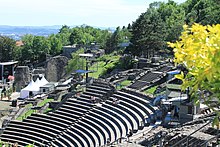
The Romans recognised that Lugdunum's strategic location at the convergence of two navigable rivers made it a natural communications hub. The city became the starting point of main Roman roads in the area, and it quickly became the capital of the province, Gallia Lugdunensis. Two Emperors were born in this city: Claudius, whose speech is preserved in the Lyon Tablet in which he justifies the nomination of Gallic Senators, and Caracalla.
Early Christians in Lyon were martyred for their beliefs under the reigns of various Roman emperors, most notably Marcus Aurelius and Septimius Severus.[22] Local saints from this period include Blandina, Pothinus, and Epipodius, among others. The Greek Irenaeus was the second bishop of Lyon during the latter part of the second century.[23] To this day, the archbishop of Lyon is still referred to as "Primat des Gaules".[24]
Burgundians fleeing the destruction of Worms by the Huns in 437 were re-settled in eastern Gaul. In 443 the Romans established the Kingdom of the Burgundians, and Lugdunum became its capital in 461. In 843, under the Treaty of Verdun, Lyon went to the Holy Roman Emperor Lothair I. It later was made part of the Kingdom of Arles which was incorporated into the Holy Roman Empire in 1033. Lyon did not come under French control until the 14th century.
Modern Lyon
Fernand Braudel remarked, "Historians of Lyon are not sufficiently aware of the bi-polarity between Paris and Lyon, which is a constant structure in French development...from the late Middle Ages to the Industrial Revolution".[25] In the late 15th century, the fairs introduced by Italian merchants made Lyon the economic counting house of France. Even the Bourse (treasury), built in 1749, resembled a public bazaar where accounts were settled in the open air. When international banking moved to Genoa, then Amsterdam, Lyon remained the banking centre of France.
During the Renaissance, the city's development was driven by the silk trade, which strengthened its ties to Italy. Italian influence on Lyon's architecture is still visible among historic buildings.[26] In the late 1400s and 1500s Lyon was also a key centre of literary activity and book publishing, both of French writers (such as Maurice Scève, Antoine Heroet, and Louise Labé) and of Italians in exile (such as Luigi Alamanni and Gian Giorgio Trissino).
In 1572, Lyon was a scene of mass violence by Catholics against Protestant Huguenots in the St. Bartholomew's Day Massacre. Two centuries later, Lyon was again convulsed by violence during the French Revolution, when the citizenry rose up against the National Convention and supported the Girondins. The city was besieged by Revolutionary armies for over two months before it surrendered in October 1793. Many buildings were destroyed, especially around the Place Bellecour, and Jean-Marie Collot d'Herbois and Joseph Fouché administered the execution of more than 2,000 people. The Convention ordered that its name be changed to "Liberated City", and a plaque was erected that proclaimed "Lyons made war on Liberty; Lyons no longer exists". A decade later, Napoleon ordered the reconstruction of all the buildings demolished during that period.
The convention was not the only target within Lyon during the French Revolution. After the Convention faded into history, the French Directory appeared and days after the September 4, 1797 Coup of 18 Fructidor, a Directory's commissioner was assassinated in Lyon.
The city became an important industrial town in the 19th century. In 1831 and 1834, the canuts (silk workers) of Lyon staged two major uprisings for better working conditions and pay. In 1862, the first of Lyon's extensive network of funicular railways began operation.
During World War II, Lyon was a centre for the occupying Nazi forces, including Klaus Barbie, the infamous "Butcher of Lyon". However, the city was also a stronghold of the French Resistance, the many secret passages known as traboules, enabled people to escape Gestapo raids. On 3 September 1944, Lyon was liberated by the 1st Free French Division and the Forces Françaises de l'Intérieur. The city is now home to a Resistance museum.[27][28]
Geography
The Rhône and Saône converge to the south of the historic city centre, forming a peninsula – the "Presqu'île" – bounded by two large hills to the west and north and a large plain eastward. Place Bellecour is located on the Presqu'île between the two rivers and is the third-largest public square in France. The broad, pedestrian-only Rue de la République leads north from Place Bellecour.
The northern hill is La Croix-Rousse, known as "the hill that works" because it is traditionally home to many small silk workshops, an industry for which the city has long been renowned.[29]
The western hill is Fourvière, known as "the hill that prays" because it is the location for Basilica of Notre-Dame de Fourvière, several convents, and Archbishop residence. The district, Vieux Lyon, also hosts the Tour métallique (a highly visible TV tower, replicating the last stage of the Eiffel Tower) and one of the city's railways.[30] Fourvière, along with portions of the Presqu'île and much of La Croix-Rousse, is designated as a UNESCO World Heritage Site.[31]
East of the Rhône from the Presqu'île is a large flat area upon which sits much of modern Lyon and contains most of the city's population. Situated in this area is La Part-Dieu urban centre, which clusters the landmark structures Tour Incity, Tour Part-Dieu, Tour Oxygène, and Tour Swiss Life, as well as the city's primary railway station, Gare de Lyon-Part-Dieu.
North of this district lays the sixth arrondissement, which is home to one of Europe's largest urban parks, the Parc de la Tête d'or, as well as Lycée du Parc and Interpol's world headquarters.
Climate
Lyon has a humid subtropical climate (Köppen: Cfa), bordering on an oceanic climate (Cfb) due to the higher average temperature being around 22 °C.[32] But in modified classifications such as that of Trewartha, France's third largest city has an oceanic climate (Do). The mean temperature in Lyon in the coldest month is 3.2 °C (37.8 °F) in January and in the warmest month in July is 22 °C (71.6 °F). Precipitation is adequate year-round, at an average of 830 mm (32.7 in), but the winter months are the driest. The highest recorded temperature was 40.5 °C (104.9 °F) on 13 August 2003 while the lowest recorded temperature was −24.6 °C (−12.3 °F) on 22 December 1938.[33]
| Climate data for Lyon (LYN), elevation: 197 m (646 ft), 1991–2020 normals, extremes 1920–present | |||||||||||||
|---|---|---|---|---|---|---|---|---|---|---|---|---|---|
| Month | Jan | Feb | Mar | Apr | May | Jun | Jul | Aug | Sep | Oct | Nov | Dec | Year |
| Record high °C (°F) | 19.1 (66.4) |
21.9 (71.4) |
26.0 (78.8) |
30.1 (86.2) |
34.2 (93.6) |
38.4 (101.1) |
40.4 (104.7) |
40.5 (104.9) |
35.8 (96.4) |
28.4 (83.1) |
23.0 (73.4) |
20.2 (68.4) |
40.5 (104.9) |
| Average high °C (°F) | 7.1 (44.8) |
9.0 (48.2) |
13.8 (56.8) |
17.4 (63.3) |
21.5 (70.7) |
25.6 (78.1) |
28.2 (82.8) |
28.0 (82.4) |
23.1 (73.6) |
17.7 (63.9) |
11.4 (52.5) |
7.7 (45.9) |
17.5 (63.5) |
| Daily mean °C (°F) | 4.1 (39.4) |
5.2 (41.4) |
9.0 (48.2) |
12.3 (54.1) |
16.3 (61.3) |
20.3 (68.5) |
22.6 (72.7) |
22.3 (72.1) |
17.9 (64.2) |
13.7 (56.7) |
8.1 (46.6) |
4.8 (40.6) |
13.0 (55.4) |
| Average low °C (°F) | 1.1 (34.0) |
1.4 (34.5) |
4.2 (39.6) |
7.2 (45.0) |
11.2 (52.2) |
15.0 (59.0) |
17.0 (62.6) |
16.6 (61.9) |
12.8 (55.0) |
9.6 (49.3) |
4.9 (40.8) |
2.0 (35.6) |
8.6 (47.5) |
| Record low °C (°F) | −23.0 (−9.4) |
−22.5 (−8.5) |
−10.5 (13.1) |
−4.4 (24.1) |
−3.8 (25.2) |
2.3 (36.1) |
6.1 (43.0) |
4.6 (40.3) |
0.2 (32.4) |
−4.5 (23.9) |
−9.4 (15.1) |
−24.6 (−12.3) |
−24.6 (−12.3) |
| Average precipitation mm (inches) | 49.8 (1.96) |
41.6 (1.64) |
49.4 (1.94) |
68.9 (2.71) |
80.9 (3.19) |
74.1 (2.92) |
67.4 (2.65) |
65.5 (2.58) |
82.5 (3.25) |
99.8 (3.93) |
87.2 (3.43) |
53.7 (2.11) |
820.8 (32.31) |
| Average precipitation days (≥ 1.0 mm) | 8.1 | 7.9 | 8.4 | 9.0 | 10.3 | 8.5 | 7.5 | 7.2 | 7.3 | 9.9 | 9.4 | 9.2 | 102.8 |
| Mean monthly sunshine hours | 71.1 | 102.4 | 173.7 | 197.7 | 223.8 | 256.5 | 288.1 | 263.1 | 204.1 | 131.4 | 78.9 | 58.7 | 2,049.5 |
| Source: Meteo France[34] | |||||||||||||
| Climate data for Lyon (LYN), elevation: 201 m, 1961-1990 normals and extremes | |||||||||||||
|---|---|---|---|---|---|---|---|---|---|---|---|---|---|
| Month | Jan | Feb | Mar | Apr | May | Jun | Jul | Aug | Sep | Oct | Nov | Dec | Year |
| Record high °C (°F) | 16.3 (61.3) |
21.4 (70.5) |
25.7 (78.3) |
28.0 (82.4) |
29.4 (84.9) |
34.4 (93.9) |
39.8 (103.6) |
37.1 (98.8) |
33.8 (92.8) |
28.4 (83.1) |
22.6 (72.7) |
20.2 (68.4) |
39.8 (103.6) |
| Mean maximum °C (°F) | 10.2 (50.4) |
14.4 (57.9) |
15.9 (60.6) |
18.6 (65.5) |
23.1 (73.6) |
28.8 (83.8) |
32.8 (91.0) |
28.1 (82.6) |
27.3 (81.1) |
19.7 (67.5) |
14.1 (57.4) |
9.5 (49.1) |
32.8 (91.0) |
| Average high °C (°F) | 6.1 (43.0) |
8.2 (46.8) |
11.6 (52.9) |
15.2 (59.4) |
19.1 (66.4) |
22.9 (73.2) |
26.1 (79.0) |
26.0 (78.8) |
22.4 (72.3) |
17.1 (62.8) |
10.0 (50.0) |
6.4 (43.5) |
15.9 (60.7) |
| Daily mean °C (°F) | 3.0 (37.4) |
4.9 (40.8) |
7.4 (45.3) |
10.2 (50.4) |
14.0 (57.2) |
17.6 (63.7) |
20.6 (69.1) |
20.0 (68.0) |
17.1 (62.8) |
12.7 (54.9) |
6.7 (44.1) |
3.9 (39.0) |
11.5 (52.7) |
| Average low °C (°F) | 0.2 (32.4) |
1.4 (34.5) |
2.9 (37.2) |
5.2 (41.4) |
9.1 (48.4) |
12.5 (54.5) |
14.8 (58.6) |
14.4 (57.9) |
11.7 (53.1) |
8.3 (46.9) |
3.5 (38.3) |
0.7 (33.3) |
7.1 (44.7) |
| Mean minimum °C (°F) | −7.0 (19.4) |
−4.7 (23.5) |
−1.4 (29.5) |
3.2 (37.8) |
7.6 (45.7) |
10.9 (51.6) |
13.1 (55.6) |
12.9 (55.2) |
8.1 (46.6) |
4.5 (40.1) |
1.0 (33.8) |
−4.7 (23.5) |
−7.0 (19.4) |
| Record low °C (°F) | −23.0 (−9.4) |
−19.3 (−2.7) |
−10.5 (13.1) |
−3.2 (26.2) |
−0.3 (31.5) |
3.6 (38.5) |
6.1 (43.0) |
5.2 (41.4) |
1.9 (35.4) |
−3.2 (26.2) |
−7.1 (19.2) |
−16.0 (3.2) |
−23.0 (−9.4) |
| Average precipitation mm (inches) | 54.0 (2.13) |
53.8 (2.12) |
72.2 (2.84) |
56.1 (2.21) |
72.6 (2.86) |
73.2 (2.88) |
54.5 (2.15) |
71.6 (2.82) |
53.2 (2.09) |
56.2 (2.21) |
68.0 (2.68) |
55.8 (2.20) |
741.2 (29.19) |
| Average precipitation days (≥ 1.0 mm) | 10.4 | 9.3 | 9.7 | 9.6 | 10.9 | 8.2 | 6.8 | 8.2 | 7.3 | 8.5 | 8.9 | 9.8 | 107.6 |
| Average snowy days | 5.5 | 3.9 | 2.5 | 1.1 | 0.0 | 0.0 | 0.0 | 0.0 | 0.0 | 0.0 | 2.0 | 4.6 | 19.6 |
| Average relative humidity (%) | 84 | 80 | 74 | 71 | 72 | 70 | 65 | 70 | 76 | 82 | 84 | 86 | 76 |
| Mean monthly sunshine hours | 62.6 | 89.8 | 147.5 | 184.2 | 215.9 | 250.9 | 292.6 | 259.0 | 208.1 | 134.3 | 75.3 | 55.4 | 1,975.6 |
| Percent possible sunshine | 23 | 31 | 41 | 46 | 47 | 54 | 62 | 60 | 56 | 40 | 27 | 21 | 42 |
| Source 1: NOAA[35] | |||||||||||||
| Source 2: Infoclimat.fr (humidity)[36] | |||||||||||||
Administration
Commune
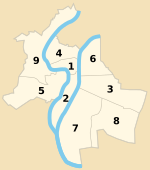
Like Paris and Marseille, the commune (municipality) of Lyon is divided into a number of municipal arrondissements, each of which is identified by a number and has its own council and town hall. Five arrondissements were originally created in 1852, when three neighbouring communes (La Croix-Rousse, La Guillotière, and Vaise) were annexed by Lyon. Between 1867 and 1959, the third arrondissement (which originally covered the whole of the Left Bank of the Rhône) was split three times, creating a new arrondissement in each case. Then, in 1963, the commune of Saint-Rambert-l'Île-Barbe was annexed to Lyon's fifth arrondissement. A year later, in 1964, the fifth was split to create Lyon's 9th – and, to date, final – arrondissement. Within each arrondissement, the recognisable quartiers or neighbourhoods are:
- 1st arrondissement: Slopes of La Croix-Rousse, Terreaux, Martinière/St-Vincent
- 2nd arrondissement: Cordeliers, Bellecour, Ainay, Perrache, Confluence, Sainte-Blandine
- 3rd arrondissement: Guillotière (north), Préfecture, Part-Dieu, Villette, Dauphiné/Sans Souci, Montchat, Grange Blanche (north), Monplaisir (north)
- 4th arrondissement: Plateau de la Croix-Rousse, Serin
- 5th arrondissement: Vieux Lyon (Saint-Paul, Saint-Jean, Saint-Georges), Saint-Just, Saint-Irénée,[37] Fourvière, Point du Jour, Ménival, Battières, Champvert (south)
- 6th arrondissement: Brotteaux, Bellecombe, Parc de la Tête d'or, Cité Internationale
- 7th arrondissement: Guillotière (south), Jean Macé, Gerland
- 8th arrondissement: Monplaisir (south), Bachut, États-Unis, Grand Trou/Moulin à Vent, Grange Blanche (south), Laënnec, Mermoz, Monplaisir-la-Plaine
- 9th arrondissement: Vaise, Duchère, Rochecardon, St-Rambert-l'Île-Barbe, Gorge de Loup, Observance, Champvert (north)
Geographically, Lyon's two main rivers, the Saône and the Rhône, divide the arrondissements into three groups:
- To the west of the Saône, the fifth arrondissement covers the old city of Vieux Lyon, Fourvière hill and the plateau beyond. The 9th is immediately to the north, and stretches from Gorge de Loup, through Vaise to the neighbouring suburbs of Écully, Champagne-au-Mont-d'Or, Saint-Didier-au-Mont-d'Or, Saint-Cyr-au-Mont-d'Or and Collonges-au-Mont-d'Or.
- Between the two rivers, on the Presqu'île, are the second, first, and fourth arrondissements. The second includes most of the city centre, Bellecour and Perrache railway station, and reaches as far as the confluence of the two rivers. The first is directly to the north of the second and covers part of the city centre (including the Hôtel de Ville) and the slopes of La Croix-Rousse. To the north of the Boulevard is the fourth arrondissement, which covers the Plateau of La Croix-Rousse, up to its boundary with the commune of Caluire-et-Cuire.
- To the east of the Rhône, are the third, sixth, seventh, and eighth arrondissements.
Mayors
This is a list of mayors of the commune of Lyon since the end of the 19th century.
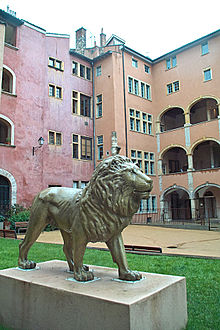
| Mayor | Term start | Term end | Party | |
|---|---|---|---|---|
| Antoine Gailleton | 1881 | 1900 | ||
| Victor Augagneur | 1900 | 30 October 1905 | PRS | |
| Édouard Herriot | 30 October 1905 | 20 September 1940 | Radical | |
| Georges Cohendy | 20 September 1940 | 1941 | Nominated and dismissed by Vichy | |
| Georges Villiers | 1941 | 1942 | Nominated and dismissed by Vichy | |
| Pierre-Louis-André Bertrand | 1942 | 1944 | Nominated by Vichy | |
| Justin Godart | 1944 | 18 May 1945 | Radical | |
| Édouard Herriot | 18 May 1945 | 26 March 1957 | Radical | |
| Pierre Montel, ad interim | 26 March 1957 | 14 April 1957 | Radical | |
| Louis Pradel | 14 April 1957 | 27 November 1976 | DVD | |
| Armand Tapernoux, ad interim | 27 November 1976 | 5 December 1976 | DVD | |
| Francisque Collomb | 5 December 1976 | 24 March 1989 | DVD | |
| Michel Noir | 24 March 1989 | 25 June 1995 | RPR | |
| Raymond Barre | 25 June 1995 | 25 March 2001 | DVD | |
| Gérard Collomb | 25 March 2001 | 17 July 2017 | PS | |
| Georges Képénékian | 17 July 2017 | 5 November 2018 | LREM | |
| Gérard Collomb | 5 November 2018 | 4 July 2020 | LREM | |
| Grégory Doucet | 4 July 2020 | Incumbent | EELV |
Metropolis

Since 2015, the commune of Lyon (48 km2 (19 sq mi) in land area) and 58 suburban communes have formed the Metropolis of Lyon (534 km2 (206 sq mi) in land area), a directly elected metropolitan authority now in charge of most urban issues. The Metropolis of Lyon is the only metropolitan authority in France which is a territorial collectivity, on par with French communes and departments. Its metropolitan council was for the first time directly elected by universal suffrage in 2020 within 14 electoral wards, the only directly elected metropolitan council in France.
The 14 electoral wards are the following (see map for location):
The 6 wards with names starting with "Lyon" are all located within the commune of Lyon. The Villeurbanne ward is coterminous with the namesake commune. All other 7 wards each group various suburban communes.
The division of the Metropolis of Lyon in large electoral wards often grouping various communes and dividing the commune of Lyon into 6 wards was criticized by the suburban mayors, as it ended the rule of 'one commune, one metropolitan councilor'. The goal of this electoral division of the metropolis was to focus metropolitan elections more on metropolitan issues than parochial communal issues, and ensure the 'one person, one vote' rule be respected, by creating electoral wards of more homogeneous population sizes. Opponents said it diluted the voice of the small suburban communes, which are now part of large electoral wards and do not each possess a representative in the metropolitan council anymore.
Presidents of the Metropolitan Council
The two first presidents of the Metropolis of Lyon's metropolitan council were chosen by indirectly elected metropolitan councilors. The current president since July 2020 was elected by new metropolitan councilors following their election by universal suffrage in March (1st round) and June (2nd round) 2020, the first direct election of a metropolitan council in France.
| President of the Metropolitan Council | Term start | Term end | Party | |
|---|---|---|---|---|
| Gérard Collomb | 1 January 2015 | 10 July 2017 | PS | |
| David Kimelfeld | 10 July 2017 | 2 July 2020 | LREM | |
| Bruno Bernard | 2 July 2020 | Incumbent | EELV |
Main sights
Antiquity
- The Roman ruins on the hillside near the Fourvière Basilica, with the Ancient Theatre of Fourvière, the Odeon of Lyon and the accompanying Gallo-Roman museum;
- Amphitheatre of the Three Gauls – ruins of a Roman amphitheatre.
Middle Ages and Renaissance
- Cathedral of St. John, a medieval church with architectural elements of the 13th, 14th and 15th centuries, also the principal religious structure in the city and the seat of the Archbishop of Lyon;
- Basilica of St-Martin-d'Ainay, one of the rare surviving Romanesque basilica-style churches in Lyon;
- Église Saint-Paul, Romanesque (12th and 13th century) and Gothic (15th–16th century) church;
- Église Saint-Bonaventure, 14th- and 15th-century Gothic church;
- Église Saint-Nizier, Gothic church from the 15th century, having a doorway carved in the 16th century by Philibert Delorme;
- Vieux Lyon (English: Old Lyon) area, Medieval and Renaissance quarter of the town, with shops, dining and cobbled streets;
- The many Renaissance hôtels particuliers of the Old Lyon quarter, such as the Hôtel de Bullioud, were also built by Philibert Delorme.
17th and 18th centuries
- City Hall on the Place des Terreaux, built by architects Jules Hardouin-Mansart and Robert de Cotte;
- Musée des beaux-arts de Lyon, fine arts museum housed in a former convent of the 17th century, including the Baroque chapelle Saint-Pierre;
- Hôtel-Dieu de Lyon (17th and 18th century), historical hospital with a baroque chapel;
- Temple du Change (17th and 18th century), former stock exchange of Lyon, Protestant temple since the 18th century;
- Place Bellecour, one of the largest town squares in Europe;
- Chapelle de la Trinité (1622), the first Baroque chapel built in Lyon, and part of the former École de la Trinité, now Collège-lycée Ampère;
- Église Saint-Polycarpe (1665–1670), Classical church;
- Église Saint-Just (16th to 18th century), Classical church;
- Saint-Bruno des Chartreux (17th and 18th century), church, masterpiece of Baroque architecture;
- Église Notre Dame Saint-Vincent (18th century), Neo-classical church.
19th century and modern city
- Opéra Nouvel (1831), renovated in 1993 by Jean Nouvel;
- Théâtre des Célestins (1877), designed by Gaspard André;
- Basilica of Notre-Dame de Fourvière, large 19th-century basilica on the top of Fourvière Hill;
- Tour métallique de Fourvière (1894);
- La Mouche Cattle Market and Abattoir (1914, 1928), designed by Tony Garnier;
- Sainte Marie de La Tourette monastery (1960) designed by Le Corbusier;
- Saint-Exupéry International Airport (formerly Satolas Airport), designed by Guillaume Gilbert;
- Gare de Lyon Saint-Exupéry (1994) by Santiago Calatrava;
- Palais des congrès de Lyon (1998), designed by Renzo Piano and a group of buildings for various functions;
- Tour du Crédit Lyonnais;
- Tour Oxygène;
- Tour Incity.
Museums
- Musée des beaux-arts de Lyon (Fine Arts Museum), main museum of the city and one of the largest art galleries in France. Housed in the "Palais Saint Pierre", a former 17th-century convent, it displays a major collection of paintings by artists (including Tintoretto; Paolo Veronese; Nicolas Poussin; Rubens; Rembrandt; Zurbaran; Canaletto; Delacroix; Monet; Gauguin; Van Gogh; Cézanne; Matisse; Picasso; Francis Bacon...); collections of sculptures, drawings and printings, decorative arts, Roman and Greek antiquities; the second largest collection of Egyptian antiquities in France after that of the Louvre; and a medal cabinet of 50.000 medals and coins.
- The Gallo-Roman Museum displaying many valuable objects and artworks found on the site of Roman Lyon (Lugdunum) such as Circus Games Mosaic, Coligny calendar and the Taurobolic Altar;
- Centre d'histoire de la résistance et de la déportation;
- Musée des Confluences, new museum of sciences and anthropology which opened its doors on 20 December 2014.
- La Sucrière, contemporary art centre;
- Hôtel-Dieu de Lyon houses the "Musée des Hospices Civils", a permanent exhibit tracing the history and practice of medicine from the Middle Ages to modern times;
- Musée des Tissus et des Arts décoratifs, decorative arts and textile museum. It holds one of the world's largest textile collections with 2,500,000 works;
- Musée d'art contemporain de Lyon, contemporary art museum;
- Musée de L'imprimerie, printing museum; Zdroj:https://en.wikipedia.org?pojem=Lyon,_France
>Text je dostupný pod licencí Creative Commons Uveďte autora – Zachovejte licenci, případně za dalších podmínek. Podrobnosti naleznete na stránce Podmínky užití.
Text je dostupný za podmienok Creative
Commons Attribution/Share-Alike License 3.0 Unported; prípadne za ďalších
podmienok.
Podrobnejšie informácie nájdete na stránke Podmienky
použitia.

